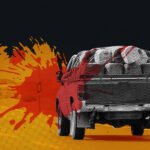On September 26, the statue of Pakistan’s Father of the Nation, Quaid-i-Azam, Mohammad Ali Jinnah, was destroyed in a bomb attack in Marine Drive area of Gwadar city, Balochistan. The banned Baloch insurgent group, Baloch Liberation Front (BLF) claimed responsibility for the bombing. Unfortunately, the statue was completely destroyed.
This is not the first time, that Baloch fighters have orchestrated such daring attack. Earlier, on June 15, 2013, the historic Ziarat Residency of Jinnah, was set alight in an arson attack by militants. The outlawed Balochistan Liberation Army (BLA) had claimed responsibility for the attack. The then provincial government of Balochistan, headed by Chief Minister Dr Abdul Malik Baloch, rebuilt and restored the Ziarat Residency to its original shape.
These attacks not only showcase ferocity, but also mistrust and disregard for Pakistani establishment among common Baloch people, who have taken up arms against state atrocities. The statue or residence of Jinnah are considered symbols of repression and exploitation of common people residing in Balochistan by Pakistani state. Balochistan has been witnessing a spate of low-level violence since decades. Currently the fifth wave of insurgency is going on in the province. The first wave started in late 1940s.
The actual data with regard to fatality caused by insurgents’ activities in not available with Pakistani Government. However, according to South Asia Terrorism Portal (SATP), the largest database for South Asian conflict zones since the year 2000, in 2716 incidents of violence, 8125 people have been killed in Balochistan, including 4334 civilians; 1631 security personnel; and 1663 insurgents. A total of 497 killings are yet to be ascertained. This is a sheer case of under reporting as in most of the incidents, journalists are not allowed to cover the news. Recently two social activists and journalists raising voice against state sponsored violence in Balochistan were found dead. Surprisingly both were in located in foreign countries during time of death. Karima Baloch died in Canada and Sajid Hussain was found dead in Sweden.
The ongoing situation in Balochistan has an intricate historical background. The province was seized by the British Empire in 1884. The former region’s territory was part of present-day Pakistan, Afghanistan and Iran. The British conceded the western part of the territory Sistan-Balochistan to Iran; the northern part to Afghanistan (southern parts of present day Helmad, Nimroz and Kandahar provinces); and the remaining part became British Balochistan. The British portion had four principalities of Makran, Kalat, Lasbela, and Kharan, which were forced to accede to either India or Pakistan during the partition process of British India. Currently, Baloch people who are spread in these three countries want to carve out “Greater Balochistan,” uniting the community of these countries.
Interestingly, the present areas comprising the province of Balochistan, were not part of the original map of newly created Pakistan on August 14, 1947. Later on, in March, 1948, the three states of Kharan, Makran and Lasbela called off the mutual suzerainty arrangements and separately acceded to Pakistan. In the same month, the Khan of Kalat acceded with Pakistan, as well (Pildat Issue Paper, 2012). However, earlier Mir Ahmad Khan, the Khan of Kalat, declared independence on August 15, 1947. Both houses of the Kalat Assembly had sanctioned this decision and rejected accession with Pakistan, but he eventually signed the accession on March 27, 1948, many believe under duress of Pakistani government.
The Baloch insurgents are in-famous for the nuisance they cause for not only the Army, but Police, Frontier Corps (FC) and Levies personnel of Pakistan. The situation in the restive province of Balochistan, is a tragic story of widespread violence and conflict between the various militant groupings and Pakistan’s security agencies. According to one estimate, approximately 55,000 Baloch fighters are engaged in violence with the military. Over a period of time, Pakistani government banned five Baloch insurgent groupings: Baloch Liberation Front, Baloch Liberation United Front, Baloch Liberation Army, Baloch Mussalah Diffa Tanzim and Baloch Republican Army.
The targets for the Baloch insurgents are: non-Baloch residents of Balochistan (Punjabis and Sindhis); gas pipelines, oil installations; police and FC check posts; Chinese citizens and installations; Security Forces.
The actual picture behind the publicised image of brutality and conflict, is that of decades of repression, torture, Human Rights violation of the common inhabitant of Balochistan by the Federal government of Pakistan. The rugged terrain of Balochistan is rich in oil, natural gas, gold and copper. In reality, Pakistan’s industries are majorly reliant on natural resources of Balochistan. Still, it has the maximum percentage of rural poverty rate, as about 60 per cent people in this province are way below the poverty line. The Baloch are also ineffectively represented in administrative, political and judicial systems. According to the United Nations Development Program (UNDP) Human Development Index (HDI) 2019, Balochistan’s people are amongst the worst affected under the Multi-Dimensional Poverty Index (MPI). Many areas in Balochistan still lack of basic facilities like school, road, hospitals, etc.
The problem of Balochistan is multi-layered as amid the four provinces, it is the largest in terms of geography but least developed in terms of basic human indices. Unfortunately, as an alternative to resolving the popular Balochi grievances, Pakistan establishment have ‘branded’ the Balochis as criminals and bandits and the government is becoming increasingly spiteful and vicious towards the whole of Baloch populace, be it an infant, child, man, woman or elderly. The Army along with FC and Levies personnel are on a widespread mission to annihilate these people and set an appropriate ‘example’ over their dead bodies. The uprising or insurgency as predicted by many, will continue, because the voice of Baloch people cannot be easily crushed and their sense of pride and self-respect can never be dented.
This post was created with our nice and easy submission form. Create your post!




Comments